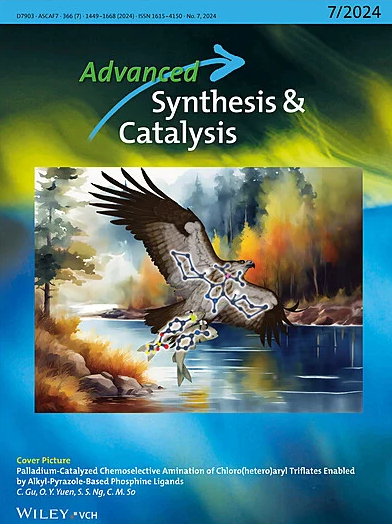Tunable Preparation of β‐Substituted Alkenoate Esters via Radical Alkenylation of C(sp3)–H Bonds with Allenoates
IF 4.4
2区 化学
Q2 CHEMISTRY, APPLIED
引用次数: 0
Abstract
A photocatalytic strategy for the radical alkenylation of aliphatic C(<i>sp</i><sup>3</sup>)–H bonds with 2,3‐allenoate esters is described. The protocol takes place upon irradiation of the reaction mixture in the presence of the decatungstate anion, which triggers C–H cleavage in the chosen aliphatic substrates. The photogenerated C‐centered radicals add regioselectively to the central C(<i>sp</i>)‐atom of the cumulenic structure, delivering an allyl‐type radical adduct that finally leads to the β‐substituted alkenoate ester of interest. When an aliphatic allenoate is adopted, the protocol leads to the selective formation of a β,γ‐alkenoate, while the corresponding phenyl ester delivers a mixture of β,γ‐ and α,β‐alkenoates. Rationalization of the observed regioselectivity is supported by computational work, which highlights how the steric demand of the allenoate ester at the radical adduct level determines the reaction outcome. The versatility of the protocol, which can also take place under (telescoped) flow conditions, is further demonstrated by the possibility to divert the reaction outcome toward the selective formation of β,γ‐ or α,β‐alkenoate esters by performing the photocatalyzed process alone or in combination with a subsequent base‐promoted C=C double bond migration, respectively.丙烯酸盐与C(sp3) -H键自由基烯化制备β -取代烯酸酯的研究
本文介绍了用 2,3-异烯酸酯对脂肪族 C(<i>sp</i><sup>3</sup>)-H 键进行自由基烯化的光催化策略。在有癸钨酸盐阴离子存在的情况下,对反应混合物进行辐照,可引发所选脂肪族底物中的 C-H 裂解。光生成的以 C 为中心的自由基会选择性地与积层结构的中心 C(<i>sp</i>)原子相加,产生烯丙基自由基加合物,最终生成所需的β-取代烯酸酯。当采用脂肪族异烯酸酯时,该方案可选择性地生成 β,γ-烯酸酯,而相应的苯基酯则可生成 β,γ-和 α,β-烯酸酯的混合物。计算工作支持了所观察到的区域选择性的合理性,突出了在自由基加成水平上烯酸异酯的立体需求如何决定反应结果。光催化过程可以单独进行,也可以与随后的碱促进 C=C 双键迁移结合进行,从而使反应结果转向选择性地形成 β,γ- 或 α,β- 烯酸酯,这进一步证明了该方案的多功能性,该方案也可以在(伸缩)流动条件下进行。
本文章由计算机程序翻译,如有差异,请以英文原文为准。
求助全文
约1分钟内获得全文
求助全文
来源期刊

Advanced Synthesis & Catalysis
化学-应用化学
CiteScore
9.40
自引率
7.40%
发文量
447
审稿时长
1.8 months
期刊介绍:
Advanced Synthesis & Catalysis (ASC) is the leading primary journal in organic, organometallic, and applied chemistry.
The high impact of ASC can be attributed to the unique focus of the journal, which publishes exciting new results from academic and industrial labs on efficient, practical, and environmentally friendly organic synthesis. While homogeneous, heterogeneous, organic, and enzyme catalysis are key technologies to achieve green synthesis, significant contributions to the same goal by synthesis design, reaction techniques, flow chemistry, and continuous processing, multiphase catalysis, green solvents, catalyst immobilization, and recycling, separation science, and process development are also featured in ASC. The Aims and Scope can be found in the Notice to Authors or on the first page of the table of contents in every issue.
 求助内容:
求助内容: 应助结果提醒方式:
应助结果提醒方式:


